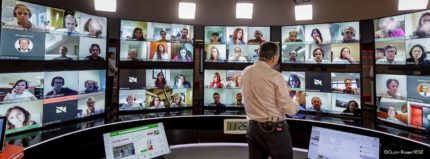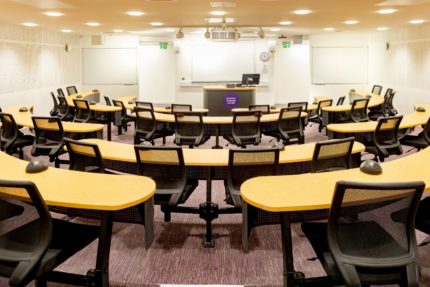Once ubiquitous, the lecture-based model of disseminating information and instruction is evolving rapidly. But we may still be too early in these evolutions and the research projects into their outcomes, to fully write off the lecture, although many – including vice chancellors – are already advocating this.
Today’s student is increasingly learning through discovery and by challenging themselves through different activities. Active and collaborative learning in small groups provides many proven benefits, such as better student engagement and making learning more likely to stick.
As a result, university and college campuses are embracing digital learning environments to better support this type of learning. So, today’s student is more likely to transfer between a range of formal and informal learning spaces across the campus, than be rooted to lecture theatres or seminar rooms.
There are still certainly occasions when larger numbers of students benefit from being in the same place. For example, building blocks of maths and other STEM subjects must still be “taught”. A compelling digital alternative to a large surface for writing complex formulae that are best viewed in context with each other still eludes us but would be a potential game-changer.
Isolation is bad
For most subjects, the lecture creates an isolated student experience and provides didactic information that can be better accessed digitally. Also, isolation is not good for wellbeing and with ever-increasing student numbers bringing a wider breadth of abilities and a diverse range of learning differences, there’s only a small percentage of students for whom listening and taking notes in lecture environments is effective.
Wi-Fi and mobile data support students to engage in a range of learning interactions using their own digital devices, individually and together, and not just within physical spaces but increasingly through accessing virtual worlds that add a new richness and reality to learning.
And students no longer need to be physically present with their lecturer to reach the most up-to-date information. It can now be accessed anytime, anywhere through websites and e-books that are constantly updated. Pearson, the world’s largest publisher of textbooks has recently announced that new books will only be published in electronic format. The world, including education, continues to change at a pace never experienced before, directly as a result of digital advancements.
This “anytime, anywhere” provision of digitalised forms of higher education is causing institutions to think more carefully about the needs of their increasingly diverse students and what is required to provide them with valuable education and social experiences. Lectures are not in their thoughts.
No physical campus?
Our sector’s version of the fourth industrial revolution – Education 4.0 – looks to evolve learning further to provide and support lifelong learning that will extend beyond university into fast-changing working lives. Can a successful, engaging and interactive digital learning environment exist in the cloud?
The concept of a virtual classroom oozes potential, and the cost of implementation is a lot less than most people imagine. One solution, developed in 2018 by Barco, the Belgium technology giant, looks like this:

Each screen has its own camera and provides that unique view back to the six students who have been allocated to it. What looks like a remote lecture with every student on the front row, is in fact far more. To ensure the technology fully engages students in real time, session polls, quizzes, and interactive tools are built into the system and interactions can fluctuate between the whole class and small break-out groups.
We know the technology works, but do we know that this environment works for student learning? It’s early days yet, but we are seeing great potential for many different groups of learners – part-time, apprentices, ex-offenders, for example, to have meaningful learning sessions without the need to travel to campus.
Is the lecture theatre dead?
Collaborative lecture spaces that support a mix of front-of-class and small group work have been around since 2011, with the first at Loughborough University. There are now many examples across the UK. They can be used for traditional lectures, but that is not what these places are developed for; they are designed for a mix of pedagogies that engage students, with lecturing forming the minority element.

In spaces like the Collaborative Wave recently installed at the Alliance Manchester Business School, digital technology easily supports the sharing of content across laptops in student groups, or to and from the front-of-class screen for all to see.
Outside formal taught hours, developments like these provide great spaces for engaged students to continue their self-directed group work, driving up the use of these expensive campus developments.
Technology should not dictate the pedagogy, but rather enable the pedagogies chosen to elicit the best learning outcomes. But the reality is that unless we know from practice how digital technology works and what scenarios can be built to engage students, provide them with real-world scenarios and experiential learning, then we can’t redesign curriculums to achieve the best learning outcomes that ever-improving digital technology now enables.
Nevertheless, there are opportunities to test drive these kind of learning spaces, for example Jisc’s Sticky Campus Roadshow. This creates a “pop-up” classroom on higher and further education campuses that host institutions can use for up to four weeks to showcase digitally rich learning spaces to staff, students and decision makers.













Collaborative learning spaces were around before 2011. For example, the LearnHigher CETL funded a number of initiatives which enabled the sort of interaction which the Collaborative Wave and other examples enable. The LearnHigher room at University of Bradford used flexible furniture, multiple screens, dual projection etc. and was the most engaging space I have ever taught in. Such spaces do need support, both technical and pedagogic. Placing lecturers in flexible spaces does not guarantee that this flexibility will be used, sometimes for very good reasons. If you cannot be absolutely confident that the technology will always work then that is… Read more »
I agree Peter! I have been teaching since way before 2011 and we didn’t have to have a specially named room to encourage collaborative learning! Since I have been an academic developer (c2010) I have been telling people that, just because they are a lecturer in a lecture room and the slot in the timetable is called a lecture, doesn’t mean you have to talk at students for hours! The bad lecture needs to die, not all ‘lectures’, and they certainly don’t need to be replaced with bad use of tech.